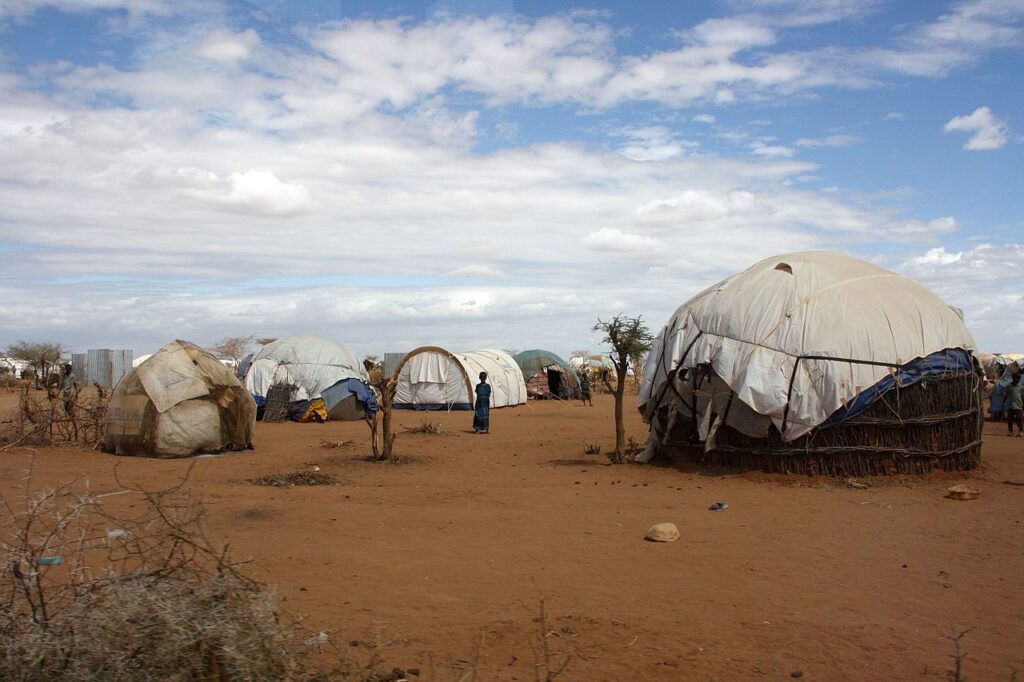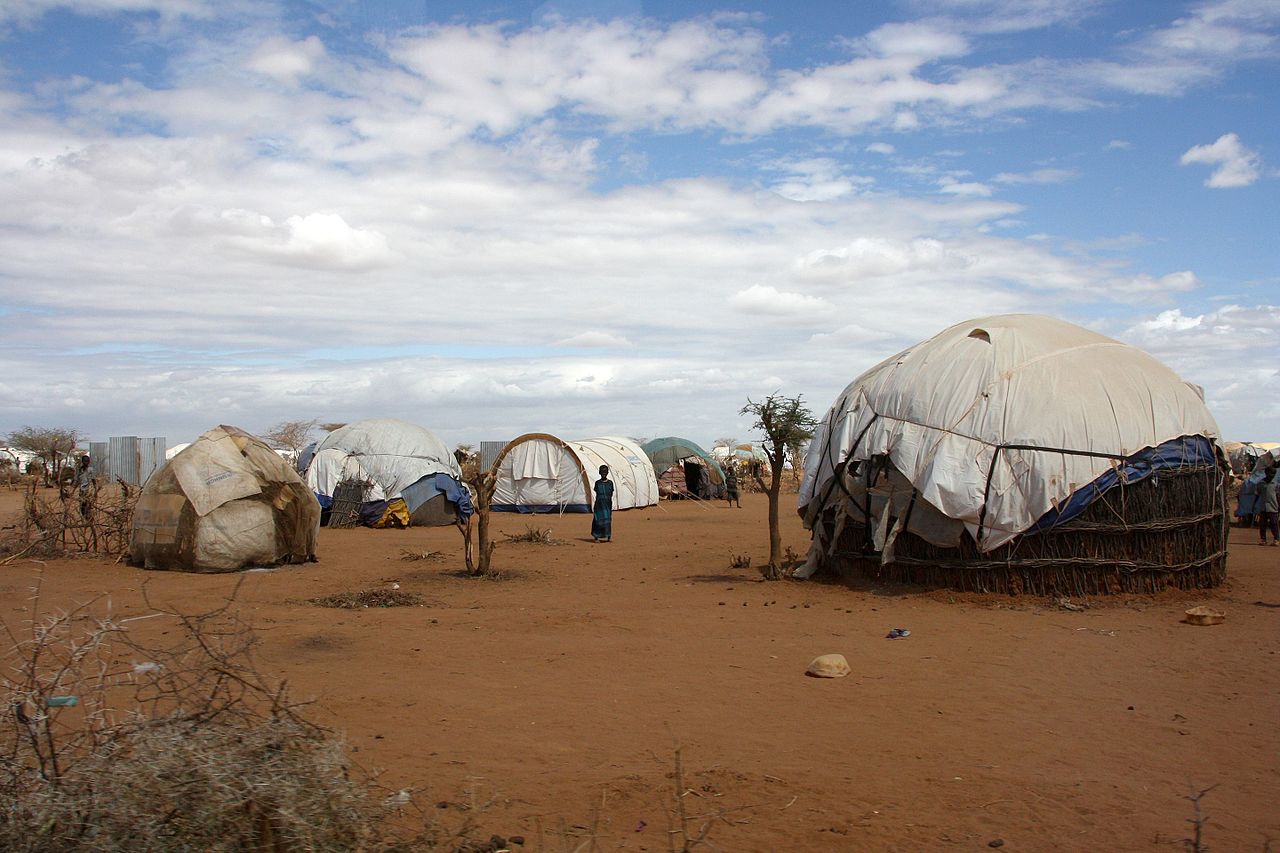
DFID – UK Department for International Development – Refugee shelters in the Dadaab camp, northern Kenya, July 2011
Photo: Pete Lewis/Department for International Development
Kavita, a migrated cold-water seller outside a Delhi metro station, is exposed to the horrendous heatwaves of Delhi. She directly experiences heatwaves, cold waves and extreme weather conditions accompanied by high levels of air pollution all around the year. The economic precarity along with extreme climate-based exposure exacerbates her overall vulnerabilities. However, she is not alone in this story. Like her, 300000 street vendors in Delhi can be called ecological refugees. In the book, Ecology and Equity, ecological refugees are those who live on the edge of ‘islands of prosperity’. Gadgil and Guha (1995) classified Indian society into three main categories: Omnivorous; Ecosystem people; and Ecological refugees. Omnivorous constitutes the real beneficiaries of the economic development, the big landholders and urban populous organized particularly in the service sector. Ecosystem people include mainly the rural population who depend on the natural resources and their environs for their survival. In comparison, ecological refugees are those who are displaced because of massive development programs such as dams or mining. Their everyday living experience is thoroughly transformed and they live a ‘life of displacement’ with barely any access to natural resources and an inability to affordability. They usually end up in the slums of a metropolis.
Who are Ecological Refugees in Indian Cities?
The conceptual understanding of the ecological refugees can be extrapolated to urban areas as the street vendors, hawkers, rickshaw pullers, vegetable sellers, or domestic workers can be characterized. They are necessary for a city’s functioning, however, the city has failed or is unwilling to provide them with basics, such as housing or water supply. Their dwellings and work spaces are susceptible to their surroundings whether it is pollution or extreme weather. One such space in metro cities is ‘slum’. Slums are characterized by poor living conditions, overcrowding, crimes, diseases and unemployment. According to the census of India (2011), around 65 million (~17% of the total urban population) account slum population. The slum population in metropolitan cities are Mumbai (54.06 %), Delhi (18.74 %), Bengaluru (10.02 %), Kolkata (32.48 %) and Chennai (18.88 %). Metropolitan cities are defined as ones having a population of more than four million by the 2011 census of India: Delhi, Mumbai, Kolkata, Chennai, Bangalore, Hyderabad, Ahmedabad, Pune, and Surat. Here, we will be observing instances from the first five of these cities. Slum dwellers are the most vulnerable and typically reside in ecologically sensitive zones. They are subjected to higher risks such as water pollution, flooding, or water scarcity. The everyday uncertainties and ‘unsettled’ nature of such urbanity equates to a ‘life of displaces’, – ecological refugees. ‘Ecological refugees’ is a broader term which encompasses not only slum dwellers but also all the urban poor who are vulnerable to ecological shocks, identity or gender-based discrimination and externalities. It is well-established now that being in a ‘slum’ is not a necessary and sufficient condition for being urban poor. This article discusses how the ecological refugees of Indian metropolitan cities are subject to various socio-ecological encounters by reviewing the existing literature. It reflects on popular ideas such as world-class cities, bourgeois environmentalism, and fragmented infrastructures that metropolitan cities experience on an everyday basis.
World Classness, Bourgeois Environmentalism and Displacements
Metropolitan cities in India proactively subscribed to the idea of a ‘world-class’ city. For example, Delhi in its upcoming master plan (2041) visioned to “…make Delhi a global metropolis and a world-class city”. This ‘world-class’ city remains undefined, though accompanied by the inter-referencing from cities such as Singapore. It also carries a certain image of a beautiful city without any blemish. Here, bourgeois environmentalism comes into operation. Bourgeois environmentalism is an elite form of environmentalism that is characterised by habitat destruction and pollution.
Nearly 100000 houses were demolished in Delhi between 1990 and 2007, and nearly half of them were bulldozed in the last three years of the timeline under “slum clearance” schemes. Most of these evictions are supported by the judiciary through public interest litigations or PILs filed by elites or omnivorous of the cities. In another instance, in India’s most populated city, 300,000 slum dwellers were evicted to fulfil the vision of world-class ‘Mumbai. The slum dwellers in both cases are the ecological refugees. They lived with minimal housing and material possessions to sustain themselves in these cities, however, got evicted and left without any rehabilitation in most of the cases. The slums are labelled as a nuisance, disorder and something ‘to get rid of’ for making world cities. Furthermore, the ‘world-class’ aspirations are fuelled by the ‘aesthetic mode of governance’ is the normative assessment of urban spaces. The ‘planned-ness’ of a project which is about the architectural and artistic value of using urban space, is tagged as formal (legal) while a settlement (for many slums) that appears grotesque or polluting is labelled as unplanned or illegal. This dichotomy is asserted by the criminalization of the poor’s informality and the legitimization of the elite’s informality. The visible difference between the land use of urban poor in the form of slums/ jhuggis which are regarded as encroachments by the bourgeois can be criminalised. The claim of urban poor over the city was weakened because of the aspiration of the middle class and sometimes because of bourgeois environmentalism.
Fragmented and Discriminated Infrastructure
As a technical-economic and social construct, network infrastructures are rooted in the social, political, historical and economic processes. The availability, accessibility and affordability of these infrastructures are effectively shaped by the socio-political entanglement. The intersecting sphere of caste, class, religion and gender operates in Indian cities particularly regulating the water supply, sewerage and other grid-based infrastructures.
Hence, in spatial and socially segregated cities, such infrastructural expansion demonstrates how the ecological refugees deny basic amenities. In Mumbai, 46 % population accessed 95 % of the supplied water while the rest 54 %, depended on only 5 %. ‘Hydraulic citizenship’ as termed by Nikhil Anand shows how belonging to the city is defined by the relationship with the city’s infrastructures. This figure shows the systematic biases of the institutions and decision-makers against the ecological refugees (urban poor). Moreover, the ecological refugees have high morbidity rates because of this deprivation of infrastructure and poor solid-liquid waste management. In Delhi, there is no provision for formal garbage collection from unauthorised developments, slums, Jughi Jhopdi settlements, etc, while other cities are no exception.
Exposure and Aggravated Vulnerabilities
Ecological refugees mostly live in the higher-risk areas in a city which are prone to flooding, or exposed to higher pollution levels, near polluted rivers, landfills, railway tracks or water-logging areas. The flooding incidents in Mumbai, Chennai, and Bengaluru explicitly reveal how the ecological refugees are systematically put at the worst end because of the lack of a drainage system, fractured governance, and dismantled water bodies, especially lakes in Bengaluru and Chennai. Putting in some statistics, in the 1980s, Chennai had more than 600 water bodies, but the 2008 master plan said that only a fraction of the lakes could be found in a healthy condition. Further, there were narratives about how the middle class was adversely affected by the Chennai 2015 flooding. , however, comprehensive research showed that the poor were the most affected, their dwelling which were situated along the river were swept away instantly, hence, leaving them homeless and displaced.
Conclusion
In Indian metropolitan cities, ecological refugees are those who are economically precarious, susceptible to uncertainties, and prone to disasters. They live as distressed, displaced and dispossessed. The governance apparatus is systematically biased against them. These biases must be recognised and rectified. Rather than perceiving ecological refugees as economically unviable, environmentally harmful and criminal, the metropolis should be an inclusive space to assimilate their claim as legitimate urban citizens. Sometimes, the ecological refugees exercise their ‘right to the city’ as the basis for this claim of being an urban resident.
***
Ritika Rajput is a doctoral student at the United Nations University, Tokyo. Her research interests are small towns, urban ecology and environment, climate change and infrastructures.
